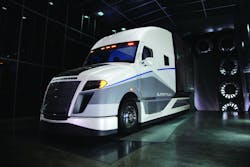Truck manufacturers generally followed the same path when it came to meeting previous emissions standards, though those paths differed in detail. In the end, all have used diesel particulate filters and then selective catalytic reduction to satisfy federal requirements to drastically lower pollutants coming out of their tailpipes. There is, however, no single “silver bullet” that will solve the next government emissions focus, a multiyear program to reduce heavy-truck emissions of greenhouse gas (GHG). Instead, fleets should get ready to see new trucks featuring a range of technologies combined in various ways depending on who’s building the truck and what that truck is supposed to do.
Reducing GHG emissions is essentially achieved by reducing fuel consumption, so when Phase 1 of the GHG regulations takes full effect in 2017, virtually all heavy-duty highway trucks will already be at the required levels. Truck makers’ motivation to get out ahead of the regulations is easy to understand. Fuel economy is important to the fleets that buy trucks, and the improvements required to meet the Phase 1 GHG reductions can be met by careful modification of current technologies.
The future of fuel economy
Click the links for stories on:
GHG Phase 2: Taking the next step
Engines: Power and efficiency
Operations: Finding an edge
Trailers: Expecting more
The proposed Phase 2 GHG rules call for an additional 18% to 24% improvement over 2017 levels by 2027. That’s a truly significant leap in heavy-truck fuel economy. Paul Menig, CEO of Tech-I-M and a consultant to the National Academy of Sciences on their work to help the Environmental Protection Agency (EPA) and the National Highway Traffic Safety Administration (NHTSA) develop the GHG rules, estimates that a typical fleet currently averages 6 mpg. Once 2027-level trucks get into widespread use—somewhere between 2030 and 2035—Menig estimates that the fleet average will reach 7.5 mpg, or about 25% above the current average.
“Today, a really good fleet is probably averaging 7.2 mpg,” he says. “That same 25% improvement should take them to 9 mpg. Some fleets have a few drivers getting over 10 mpg today. Those drivers should be able to achieve 12.5 mpg with a new vehicle post 2027.”
That’s a welcome development for any fleet. But the question is how do we get there?
Since the Phase 2 rules are still just a proposal and the public comment period on that proposal is still open, no OEM was ready to talk about specific technology paths they’ll use to achieve those gains. However, along with the proposed rule, EPA and NHTSA released a 31/2-in.-thick “Draft Regulatory Impact Analysis” that includes a menu of technologies truck makers can use to find their particular solutions. The most telling sections offer a view into what we can reasonably expect to see in a 2027 tractor or heavy truck.
Most of the tractor technologies identified by the report are already familiar to buyers of new trucks, but EPA and NHTSA anticipate pushing them to new levels of development and much broader adoption. They are:
◗ Aerodynamics. Look to the SuperTruck program to get an idea of Phase 2 aerodynamic treatments for OTR tractors, especially high-roof sleepers with elements trickling down to other applications as appropriate. Combined with new trailer treatments, expect combinations to “look a lot like ’50s custom sedans with covered wheels,” Menig says.
◗ Transmissions. Automated mechanical transmissions, automatics, and dual-clutch transmissions would be used by 90% of all heavy trucks by 2027. Their fuel saving contribution would grow as trucks move to downsize engines, necessitating more shifts per mile, Menig points out.
◗ Driveline. Expect to see some combination of 6x2 drive axles, downspeeding ratios, direct drive, and lower friction axle lubricants.
◗ Tires. Expect lower rolling resistance for all medium- and heavy-duty truck tires. Use of tire pressure maintenance systems also expands.
◗ Accessories. Expect changes in electrical accessories and air conditioning to reduce parasitic power loss.
◗ Weight reduction. The impact analysis discounted expanded use of aluminum and other light materials as having too little benefit with too high a cost; however, engine downsizing would certainly contribute here.
◗ Idle reduction. Approaches using automatic engine shutdown would extend beyond sleeper cabs to day cabs.
◗ Vehicle speed limiters. If they cannot be overridden by the truck buyer, they may be used to help certify a truck meets Phase 2 requirements.
◗ Other. Predictive cruise control is forecast for 40% of all Class 7 and 8 tractors by 2024. The report mentions other “intelligent controls,” but provides no details on what those might be.
About the Author
Jim Mele
Jim Mele is a former longtime editor-in-chief of FleetOwner. He joined the magazine in 1986 and served as chief editor from 1999 to 2017.
